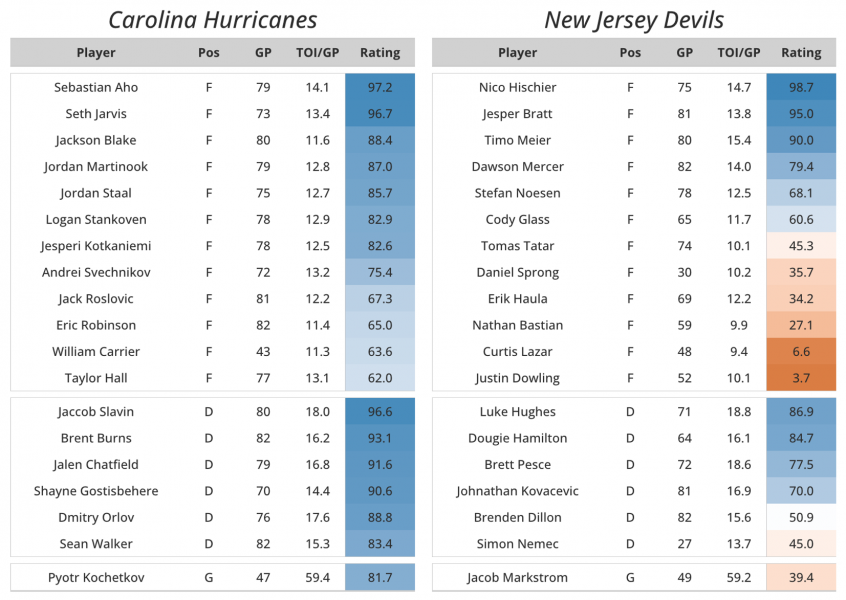We’re a day late, but we’re never a word short. The ’24-25 NHL playoffs started yesterday (two series), and the league continued their recent practice of jamming together the end of the regular season and the start of the playoffs once more. Before 2024, we always had at least two days off before the playoffs started, and that was nice (speaking to the NHL right now)! Sorry, I’m ranting… onto the preview. What a fun regular season it was! And by “fun” I mean absolutely awful for preseason team projection models. Based on my tracking since 2019, this was easily the worst collective performance by the models that I’ve seen. But that horrible performance means an especially interesting season. The Winnipeg Jets won the President’s trophy, the previous trophy winner didn’t even make the playoffs (nor did one of their unnamed challengers last year, lol), Ovechkin broke some kind of goal record, the Golden Knights made Luke and I specifically quite mad at our inability to ever project them correctly, and Shawn became a tank commander.
Just like in past years, we’re here to provide complete playoff coverage the way only Evolving Hockey can. Josh (me) and Shawn handled writing duties while Luke sweated away in RStudio giving us the models and charts and tables you’ll see below. Unlike prior years, however, we’re now using our own roster process after the exit of CapFriendly from the public space (sad face) and a brief transition to and away from another roster source. While this gives us the ability to fully track everything ourselves, this also means we have to track everything ourselves. We’ve done quite a bit of work to ensure the rosters here are as accurate as possible (injuries, substitutions, game-time decisions), but it’s possible a few players slipped through the cracks. We apologize if there is an issue there. Given we’re a day late, we did attempt to best set the rosters without any prior knowledge of the two games played yesterday, so at least there’s that. Maybe next year the NHL will give us two days to get this all done.
Ok, enough, let’s get to it!
The Model
Our playoff probabilities are generated in a three step process. We use multiple models to project “future” values for all players, use these player projections to build a game probability model that projects the winning % of any given team matchup (logistic regression), and then feed these individual game probabilities into a Monte Carlo simulation that generates the probabilities for each series. In order to complete this process, each team’s player projections are aggregated into F/D/G groups, and various metrics are used for each group which are then fed into the game probability model. With these inputs, we are able to generate home and away team winning percentage values. Once we have projected all home/away probabilities for the playoff games, we prepare the simulation.
For the simulation, in a given game, we only care about the projected winning % for the home team. Take TOR/OTT. The process laid out above gives us a winning % for each team. In game 1, TOR is the home team. We replace OTT’s projected probability with a random % between 0 and 1 since they are the away team. If TOR’s projected winning % is higher than the random number, TOR “wins” that game (they “lose” if it is lower). In game 3 when OTT is the home team, we do the same for TOR (we replace their winning % with a randomly generated %). This is done for each team game in all series and then repeated 50,000 times. Once the simulation is complete, we check how many times each team won a game, sum the total games won in a series, and arrive at each team’s projected probability.
The first step is generating multiple player-level models which produce ratings for all players in the league. For skaters, we found our xSPAR metric (Expected Standing Points Above Replacement) as well as a custom “game score” model (built using Box Score metrics) worked best for predicting future team game outcomes. Our SPAR and RAPM metrics were also tested but they did not perform quite as well for this specific task. The “game score” model we are using is similar to Dom Luszczyszyn’s Game Score model; however, we tested various box score metrics and weighted them through a “grid search” approach to optimize predicting future team game win probability.
Eastern Conference
Toronto Maple Leafs (A1) vs. Ottawa Senators (WC1)
53.8% 46.2%


There is no one happier about the Boston Bruins missing the playoffs than the Toronto Maple Leafs. After breaking the curse in 2023, winning in six games against Tampa Bay, Toronto went on to lose another game seven to Boston last spring. One of the big stories for the blue and white this season has been the continued development of Matthew Knies. He came one goal shy of 30, finishing third on the team in xGAR and seventh in GAR. He offers some size and grit that many had criticized the Leafs for lacking in previous playoff attempts. The identity of this Leafs team, which has been worse on paper than in seasons past, has been one of the boring percentages some might say. They haven’t been an offensive juggernaut, but rather average from an on-ice metrics point of view and above average in finishing and goaltending. The Leafs have lost to that before, so if you can’t beat them you might as well play like them I suppose.
It was finally the year for the young Senators team. Tim Stützle led the team in both GAR and xGAR, playing in all 82 games. Ottawa also benefited from the incredible play of Thomas Chabot and Jake Sanderson, who only played 62 of their 1,444 and 1,338 respective 5v5 minutes together. The Senators have also been sly in their transactions over the past twelve months: they acquired a solid goalie in Linus Ullmark giving up only Mark Kastelic and Joonas Korpisalo, signed low-cost free agents Adam Gaudette and Michael Amadio, and took a shot with Dylan Cozens at the deadline. Is this team poised for a deep run? Probably not. Even with Stützle playing at a legitimate 1C caliber, Cozens and Pinto behind him leaves much to be desired this spring. But a good goalie, nothing to lose, and an opponent that everyone believes is cursed, perhaps the Senators can pull out the upset.
Tampa Bay Lightning (A2) vs. Florida Panthers (WC1)
46.3% 53.7%

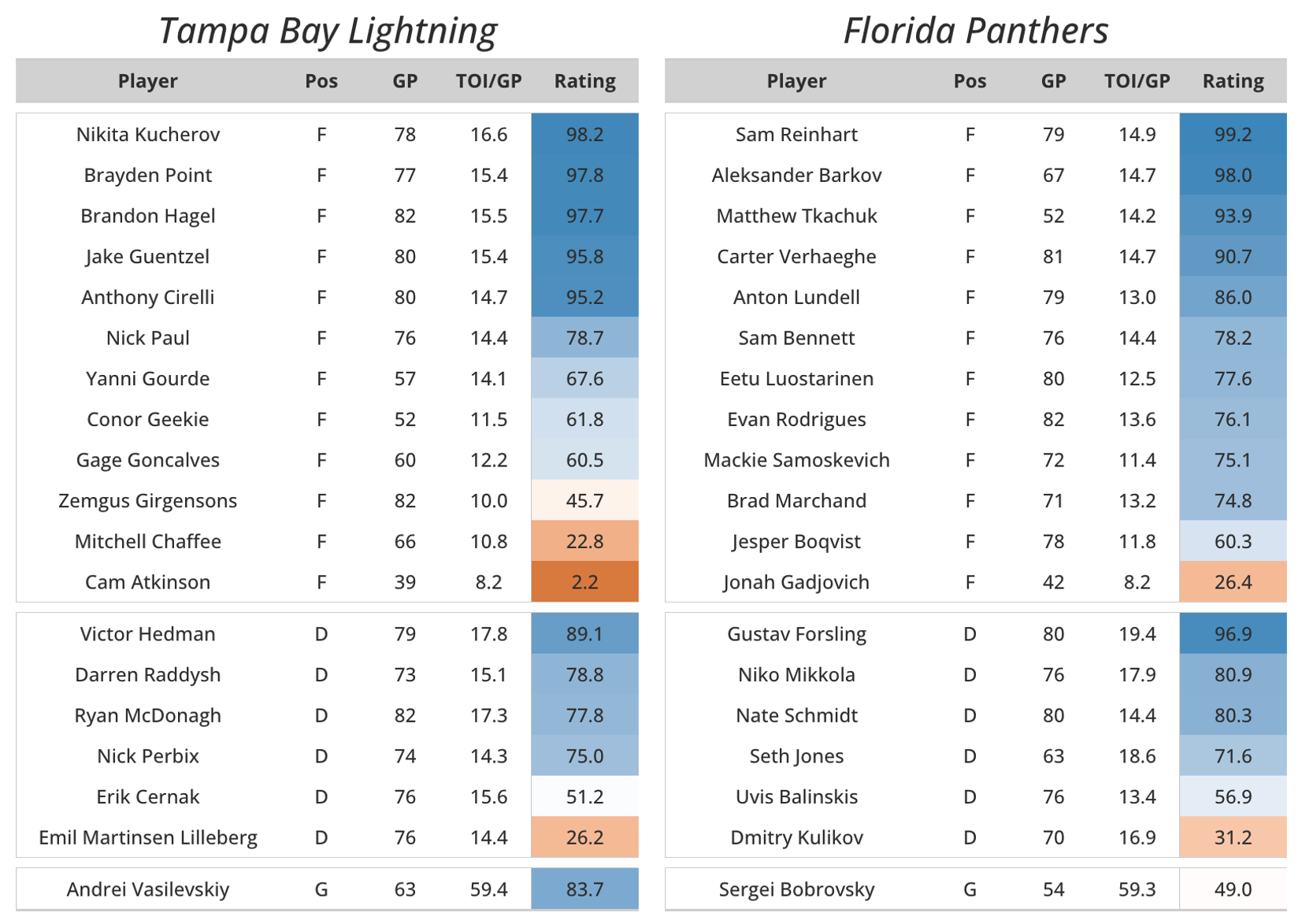
One simply shakes their head with amazement when Tampa Bay pulls off another season like this. Last summer, the Lightning front office shook things up letting Stamkos walk, sending Sergachev to Utah, and signing Jake Guentzel. The first two are golfing now while the last one led the Lightning in xGAR and finished second in GAR. Recognizing the strong play and opportunity for the team, the front office went out and acquired Oliver Bjorkstrand and Yanni Gourde from the Kraken at the deadline. Bjorkstrand’s fit in like a glove, contributing 1.1 SPAR in his 18 games with the team. Unfortunately, he’ll miss the first round, which really is a shame for both one of our “guys” and the Lightning in general. That said among their recent acquisitions, Gourde adds a good mix of intensity and humor that helps drive teams in the playoffs…or so the hockey men say. Plus, they still have Andrei Vasilevsky (Vezina finalist again?), finishing the season third in goalie GAR. Tampa doesn’t have an easy first opponent in Florida, but they stand a much better chance than they did last year.
Heading into the 2024-25 season, the Florida Panthers were our favorite to win the Atlantic Division and would likely compete for the President’s Trophy. Well, the Panthers finished 10 points below our projection (108 standing points), losing home ice in the process. Still, the model likes them quite a bit. Sam Reinhart backed up his 57 goal season last year as well as can be expected, scoring 39 goals this year while leading the team in both GAR and xGAR. The Panthers have also gotten strong play from their depth on the backend. While Gustav Forsling seems to finally be getting the praise he deserves, Nate Schmidt and Niki Mikkola put up strong numbers defensively. This team is solid in pretty much every aspect of the game except even-strength finishing. That is similar to how their prior Stanley Cup winning team was constructed, which is part of why the model has them as a favorite on the road. However, this team isn’t what they were last year. Either way, the battle of (for?) Florida is always an absolute blast.
Washington Capitals (M1) vs. Montreal Canadiens (WC2)
72.3% 27.7%

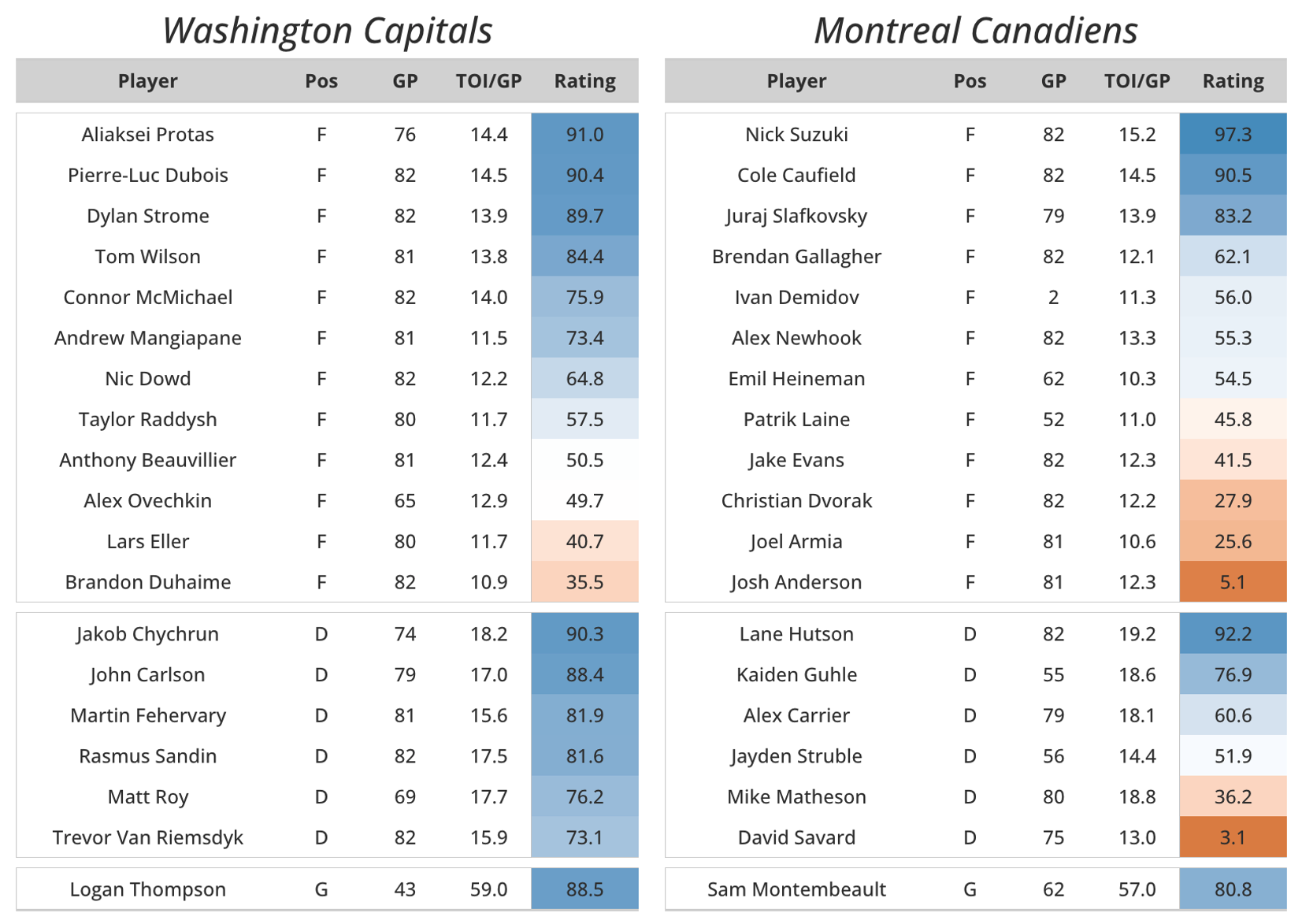
Earlier this season on the podcast, we made the mistake of saying the Capitals had roughly the same team as they did in ’23-24. For those who listen, you know we clearly know what we’re talking about (the twins clearly don’t care, but we were a little ashamed). Pierre-Luc Dubois, Jakob Chychrun, and Andrew Mangiapane are three summer acquisitions that had a big impact for the Caps. Each finished top-5 on the team in GAR and xGAR, with Dubois finishing first in the former. This isn’t the ’09-10 Capitals team that dominated with their star power. Dubois’ 6.2 SPAR would rank 5th on that team behind Backstrom, Green, Semin, and Ovechkin. That said, this team doesn’t really have any anchors. There isn’t a player who has had a well below replacement level impact on the team this season, they are average or good in all of the RAPM impacts across the board, and, honestly, they’re kind of a vibe. The one scary thing for the Capitals is that since the Four Nations break, they rank dead last in the NHL in 5v5 save percentage at .875. So, while their underlying metrics have been strong down the stretch, their goal differential has fallen at 5v5. Unlike in September when our model didn’t expect much out of the team, giving them a 27% chance to make the playoffs, there is a lot expected of them now. We’ll see if they can keep it rolling.
And then we have the Canadiens. If we didn’t expect much out of the Capitals, we expected even less out of the Canadiens. This was supposed to be another development season for the Habs, especially when Reinbacher and Laine went down in the preseason. Similar to how Pierre-Luc Dubois rose to the occasion this season, Nick Suzuki gave the Canadiens number one center production. Cole Caufield, who may as well be a veteran at this point, helped out quite a bit too with 37 goals. And we can’t forget about the consensus Calder favorite, Lane Hutson. Still, the model here is (simply) more shocked at how the Bruins, Rangers, Sabres, and Red Wings fumbled the bag than at Montreal being here. Because of that, they are complete underdogs in this series. As the saying goes, an underdog is a hungry dog; and hungry dogs skate faster. The Bell Centre will be buzzing for game three and anything can happen in the home of hockey.
Carolina Hurricanes (M2) vs. New Jersey Devils (M3)
84.9% 15.1%
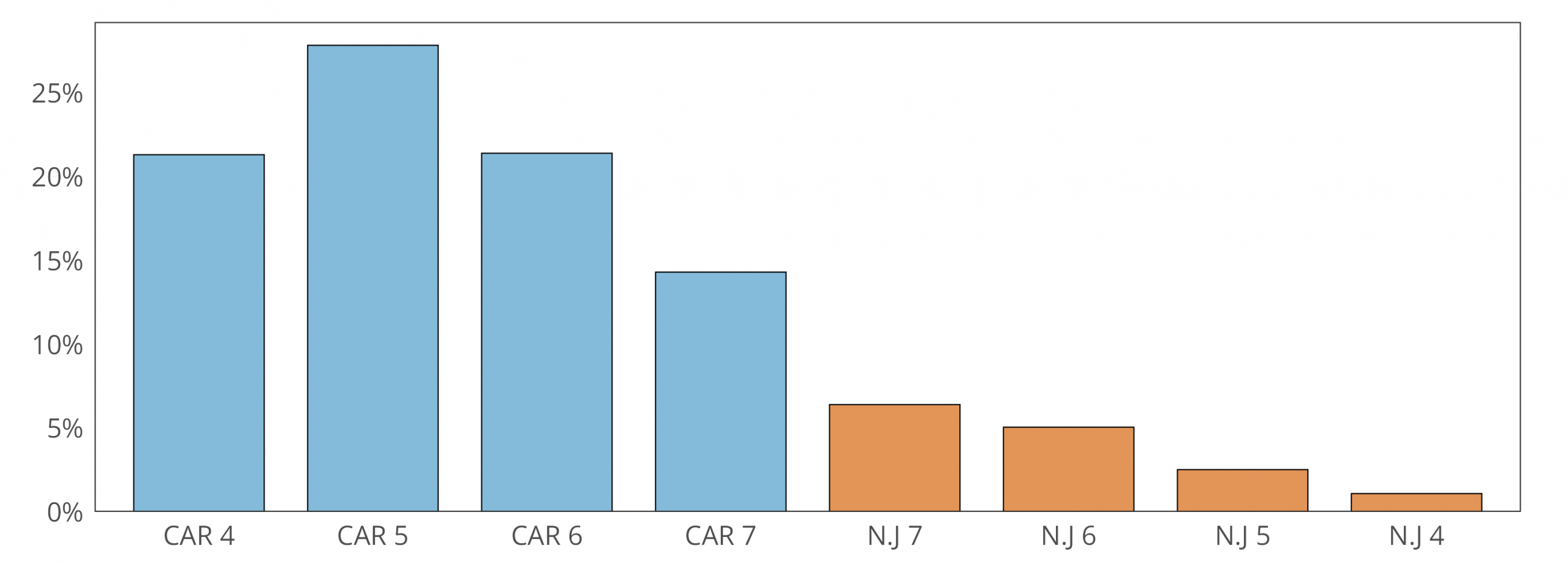
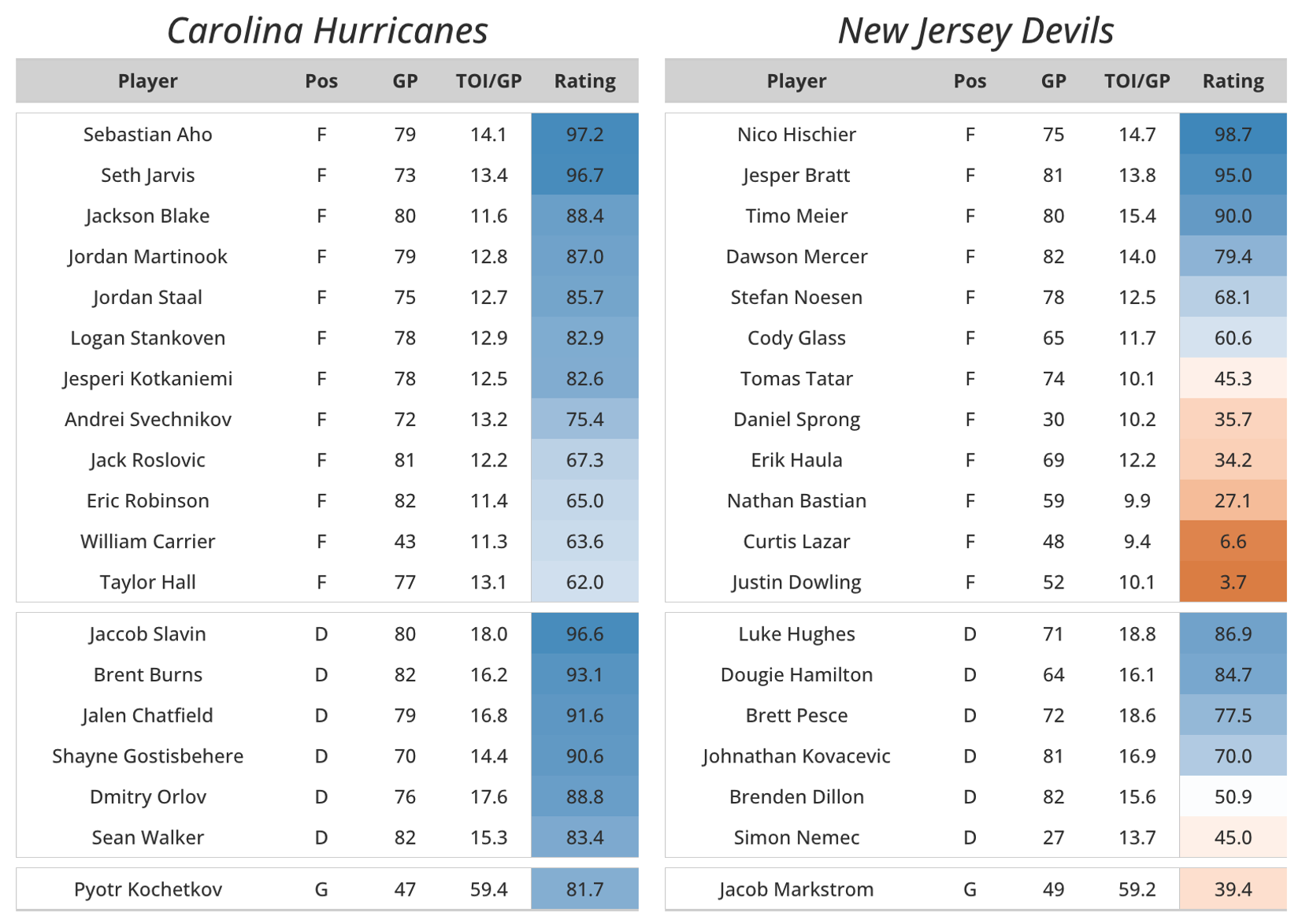
The Corsi Canes. Gaming their shot attempts, building a system that distorts players, creating a team that any model will pick every time. They should let you place bets on where Carolina will finish in 5v5 CF%, because that would be a safer investment than US Treasuries. Just like prior seasons, they finished first in CF% (by a wide margin) at 59.5, first in xGF% at 55.4, and 13th in GF% at 51.4. There really aren’t more fitting results for a team run by Eric Tulsky. We’ve been getting this team for the last four or five years, without a Stanley Cup appearance yet. They replaced Brady Skjei with Shayne Gostisbehere, a long-time favorite of Evolving Hockey (it’s worked out beautifully, by the way). Their attempt to replace Guentzel with Mikko Rantanen (kind of), really didn’t work, but they didn’t succumbed to the sunk cost fallacy and are attempting to recreate him in the aggregate. One story that’s been under-covered this season is the falloff of Andrei Svechnikov. Even with that, this is a strong team that the model adores. Hopefully we don’t lose lots of logs here
The Devils took, “New year, new me,” a bit to literally in 2025. Since the turn of the calendar year, the Devils are only 17-17-4. They saw injuries to key players starting with Jacob Markstrom on January 22, then Siegenthaler on February 4, Jack Hughes on March 3, and Dougie Hamilton on March 4. If this team wasn’t a shell of itself due to injuries, we’d be talking about a much tighter series. But before we count out the Devils, we should make mention of the production from Nico Hischier. He finished in the second tier of our Hart selection with an average GAR & xGAR of 24.1, ranking third in the league. Additionally, and I know we don’t talk about points here, but our boy Jesper Bratt finished with a career-high 88. Okay, it’s really difficult to see a team, trimmed to a shell of their former selves, head into what could’ve been the best round-one matchup. Maybe the Devils will pull off a miracle, but our logs would be a casualty. Do you want that? No, you do not.
Western Conference
Winnipeg Jets (C1) vs. St. Louis Blues (WC2)
69.6% 30.4%

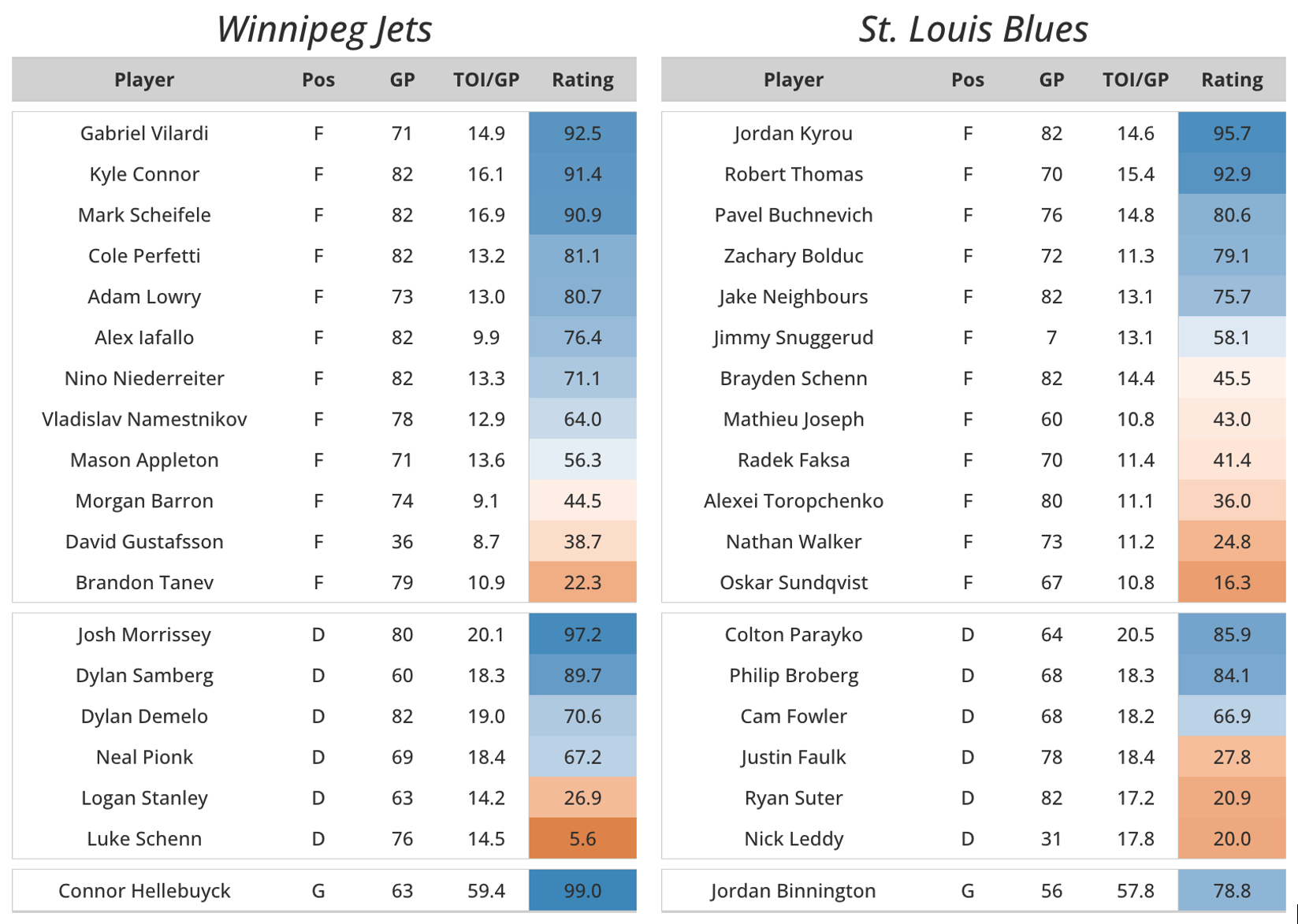
We’ve never said a single mean thing about Winnipeg (this is true, you can actually go look this up), but this year, what the f**k. You guys are our closest team neighbor, and you get to just casually have this kind of season? The ’24-25 Jets finished with the 3rd most team GAR since 2007 (only behind ’18-19 Tampa Bay and ’22-23 Boston), they won the Presidents trophy, and have arguably the greatest goalie of the 21st century. As the almost certain Vezina winner, Hellebuyck’s 51.4 GAR this season ranks 2nd all time in our database (behind Saros in ’22-23). The Jets skaters are an interesting group. Powered by possibly the best pair of defensemen in the league this past season in Josh Morrissey and Dylan Samberg (who don’t play together at all), the top forward line combination of Scheifele and Connor and solid depth guys like Lowry and Appleton, the Jets skaters, while not the strongest in the league, round out a surprisingly deep team. But I’d be lying if I didn’t emphasize the importance of their goalie to the Jets this year. If the Jets go far in the playoffs this spring, it will be because of Hellebuyck. If the Jets don’t make it to the second round, it will almost certainly be because of Hellebuyck. Usually, I might comment on the uncertainty of this kind of team construction, but it’s Hellebuyck. Who can doubt him?
Every regular season there’s one team that comes out of nowhere down the stretch and surprises everyone. While it took until the last game, and they needed one extra regulation win to grab the tie-breaker from Calgary, they snuck in. The Blues are a fascinating team – one of the four teams (along with TOR, MIN, and MTL) in the league that didn’t finish in the top-16 in 5v5 Corsi For % in the regular season, the Blues relied much more on a solid combination of shooting, a puzzlingly effective defensemen group, and some luck. Maybe more interestingly, the Blues’ bet on two offer-sheets last summer may have actually barely pushed them into their wild card spot. Dylan Holloway and Philip Broberg both finished among the top-5 players for the Blues in total xGAR, with Holloway ending the ’24-25 season as the leader (unfortunately, it looks like he may miss most of this series). While volatile and always uncertain, Jordan Binnington provided another solid season after a surprising showing at the 4 Nations tournament. Unfortunately, their first-round opponent may be our Stanley Cup favorite heading into the start of the playoffs (after reconsideration the favorite here is Carolina, but the Jets are close).
Dallas Stars (C2) vs. Colorado Avalanche (C3)
40.1% 59.9%
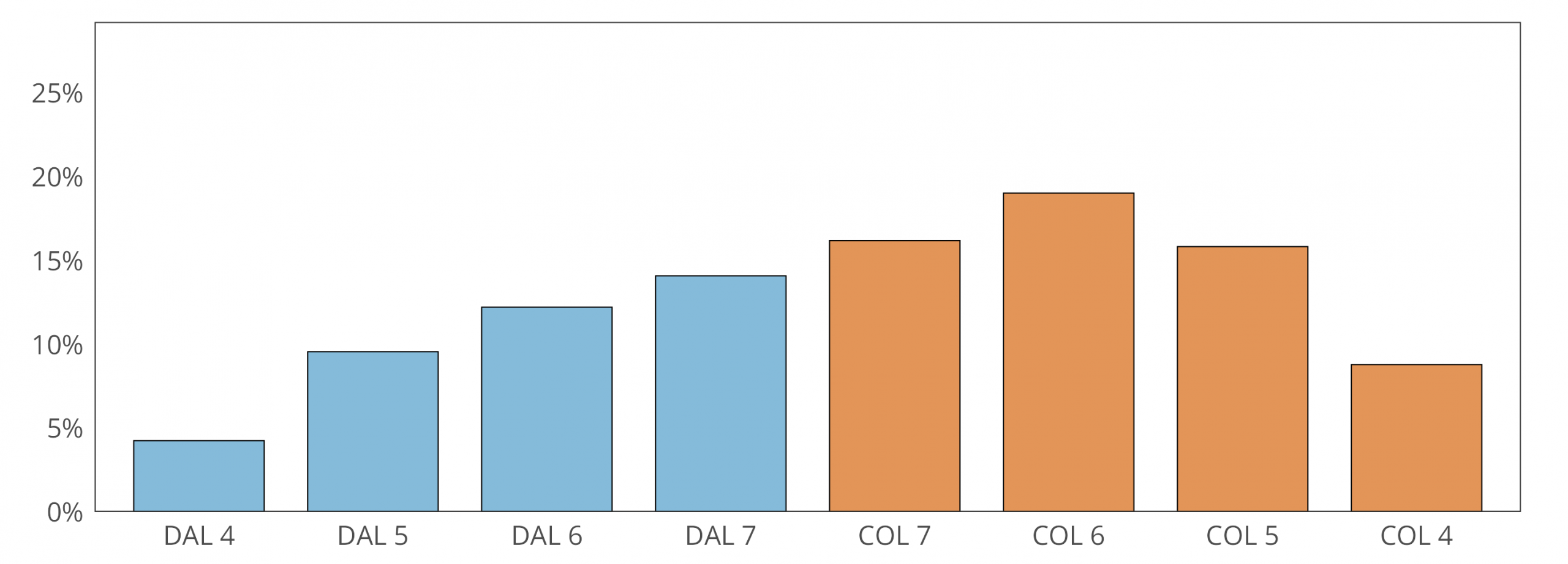
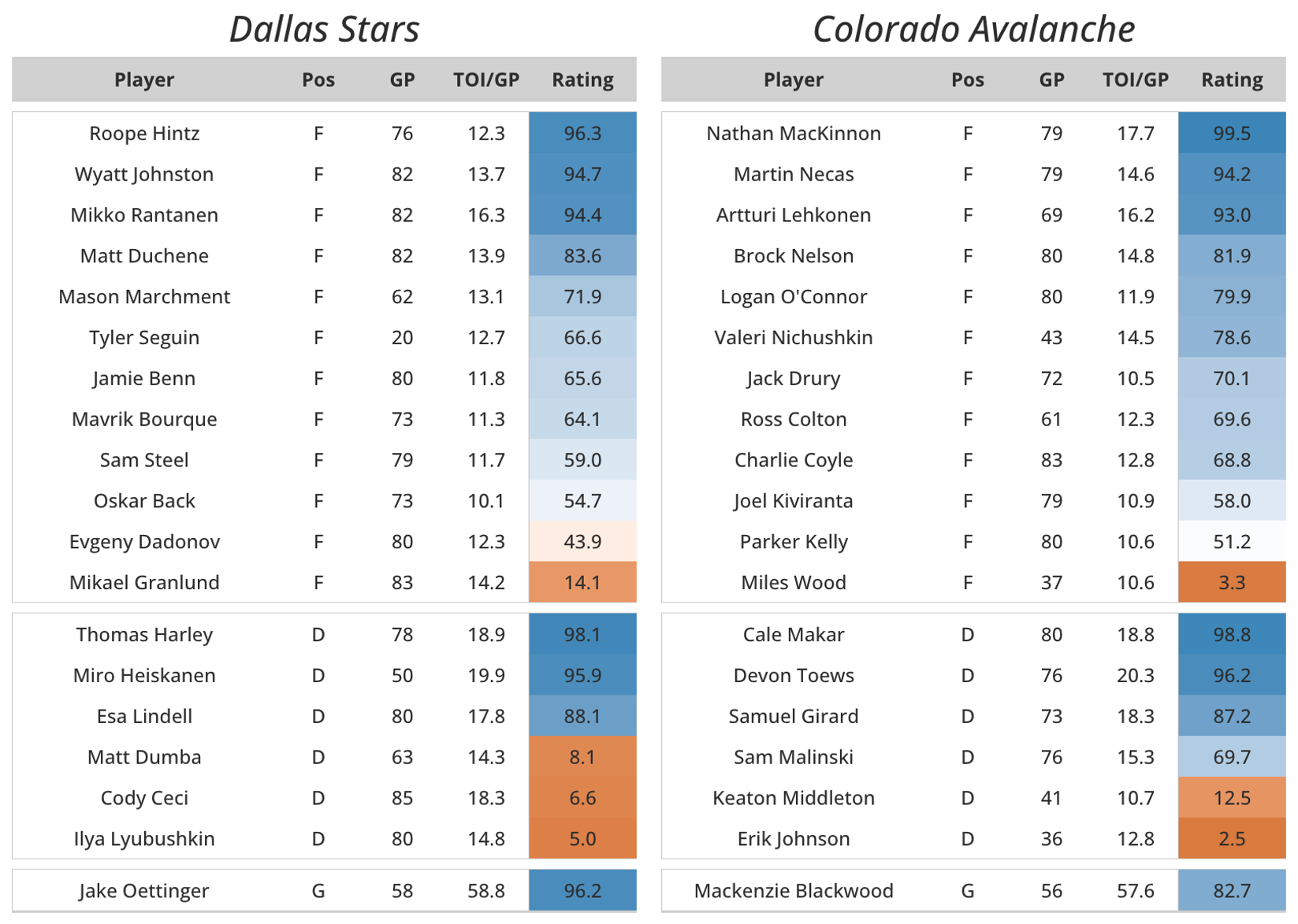
This is the matchup of problematic teams for me as a longtime Wild fan. I no longer actually dislike either team – they’ve both had a bunch of players for years that our metrics love – I just like to remind myself of this ancient hatred so as to feel something. Just like our team projections predicted, the Central ended up being the strongest division in the league, and honestly it’s a shame both of these teams have to play in the first round. The story of the season, as far as we’re concerned, is Thomas Harley’s sophomore campaign. Our pick for the Norris this season, he finished 3rd in total xGAR among all skaters in the league and continues to be one of the most overlooked players in the NHL. Along with possibly the best center depth in the playoffs (Hintz, Duchene, and Johnston), the Stars really are that deep. Their recent performance, however, should raise some alarms. Since the beginning of March, the Stars have the 4th worst xG differential at even-strength. Some of this is likely due to injuries, and their strong goalie tandem of Oettinger and DeSmith ensured a divisional playoff spot. The loss of Jason Robertson really hurts – when we ran our simulation with him in the lineup, this series became much closer. If he slots back in midway through, the Stars chances will improve quite a bit. Regardless, it will be fun to watch two teams that I used to hate beat each other up.
Of all the series in the first round, the “Rantanen plays against his old team in the first round” storyline may be the most interesting to come out of, at the very least, the Western Conference. Not only is he playing, in a way, to prove his worth this free agency after a shaky second half with both Carolina and Dallas, but he’s playing against his trade partner in Martin Necas, who has somewhat quietly become one of the Avalanche’s most effective players this season (4th in xGAR on Colorado since he was sent over). Colorado keeps chugging along after another solid season – they haven’t finished with less than 100 points in the standings (COVID seasons prorated) since the ’18-19 season, which is honestly just impressive stuff. After a horrible string of injury issues in the first half, the Avs still have the same kind of team we’ve grown to love (or hate, depending). With at least two awards finalists in Makar and MacKinnon, they still have one of the deepest skater groups in the league, especially if you like stats to evaluate said depth. Perennial Evolving Hockey favorites Devon Toews, Logan O’Connor, and Artturi Lehkonen, and the latter’s placement with MacKinnon and Necas sits third among all forward lines in EV Corsi For % (minimum 200 minutes). This Colorado team is about as well rounded as any in the first round. The only real question will be their collective Woods: Scott Wedge and Mackenzie Black, specifically. Mackenzie Blackwood was quite solid for the Avs after the Georgiev transition, but neither is necessarily a “proven” commodity. While I would still be irritated because my long-standing hatred of Colorado as a Wild fan is, beyond my control, still lingering, there the favorites here.
Los Angeles Kings (P2) vs. Edmonton Oilers (P3)
51.3% 48.7%
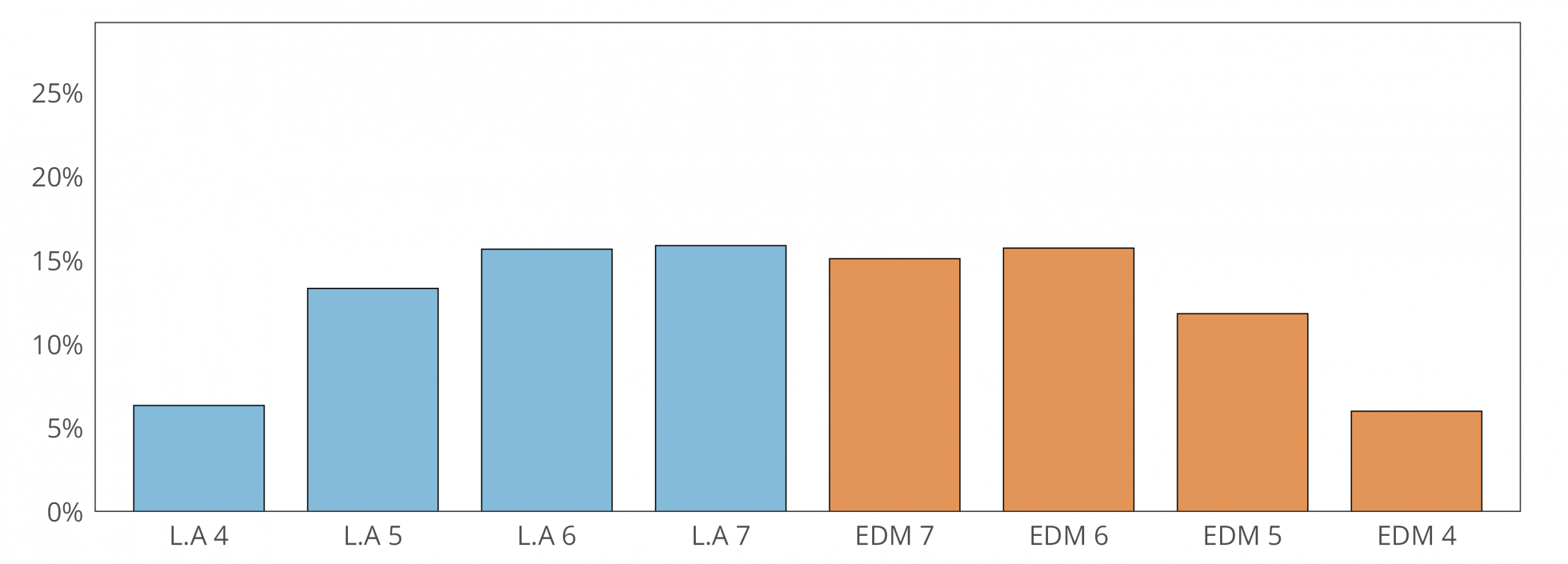
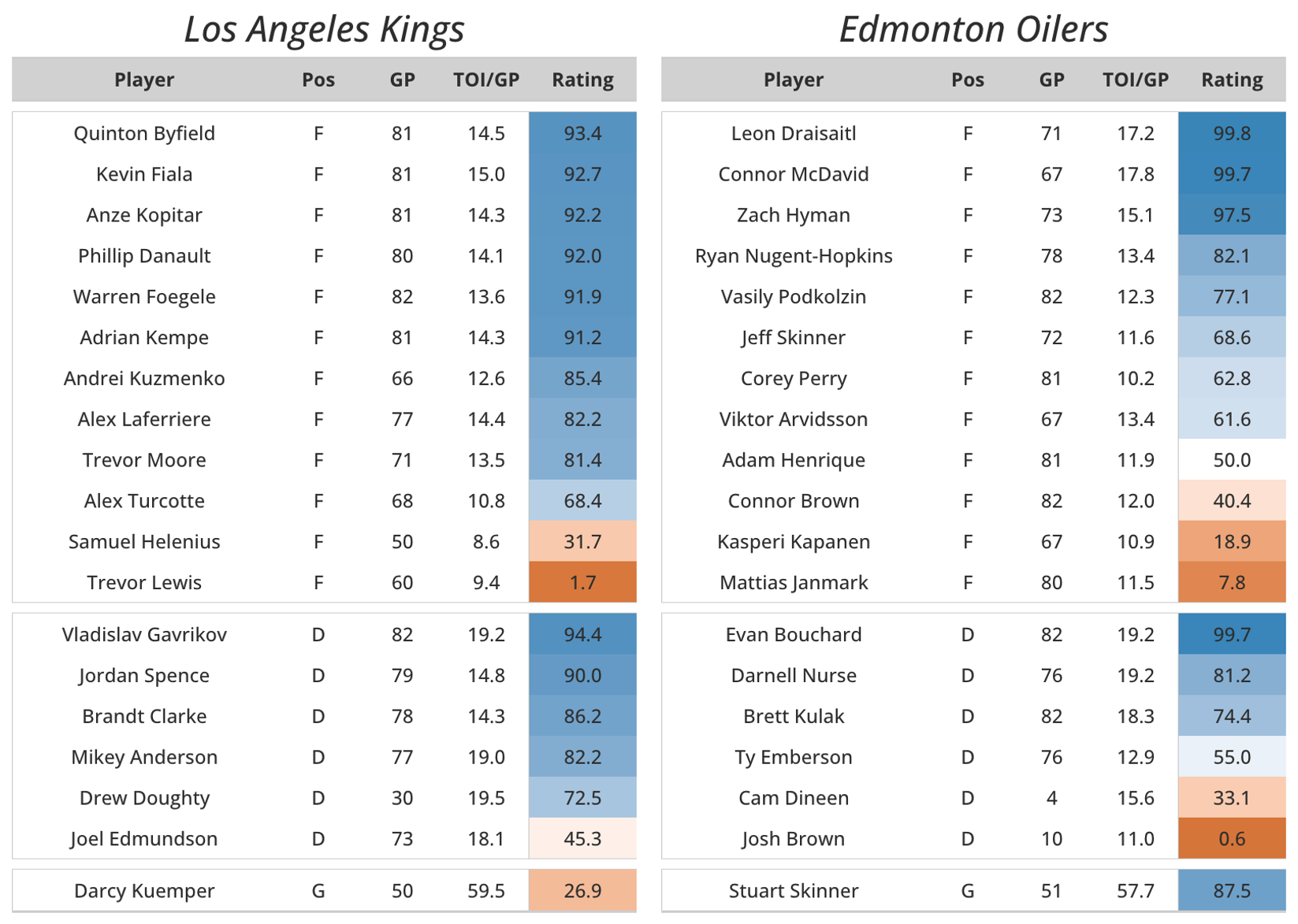
Unlike last season, where the Oilers were quite heavily favored by our playoff model in this same series, the ’24-25 Kings are the same team that got a whole lot better. This team is what we in the business call a true “weak link” team. Among their regular skaters this season, only two finished below replacement in our GAR model (I’m slightly discounting Doughty’s -0.4 GAR here as he only played 30 games after a long injury). Los Angeles has built a team with few weaknesses. While it took some time, a few of their previously underperforming acquisitions (Fiala, Gavrikov, Danault) are now among their best players. There isn’t a superstar on this roster, but the Kings are the kind of team that can relentlessly run line after line against any team, and that may just be their biggest advantage against a comparably weaker depth team like the Oilers. Just like their opponent, the big question here will be goaltending. Our playoff model is quite down on Kuemper. Every year there are at least two goalies who cause us problems like this, and every year people let us know about those goalies. While Kuemper did finish among the top-5 goalies in GAR this season (same with GSAx), Kuemper is 34 years old coming off a rough prior year. While we can’t always make sense of everything our model tells us, one thing Luke and I can make sense of is our model hating older goalies in the playoffs. Either way, the Kings stack up quite well against the Oilers, which makes this series the closest we’re projecting in the first round.
With the only Pacific division matchup this year, the Edmonton Oilers continue their now no-longer-surprising streak of playoff appearances with a 6th consecutive extra season. And they get the same first round that they had last year. People forget there used to be a time when some doubted whether McDavid and Draisaitl would be enough to overcome their decade plus mismanagement (to be honest, you can’t really blame that doubt, the Oilers management from years ago really was hilarious). After a tough loss in the Cup Final last season, the Oilers returned with another respectable 101-point season, finishing 4th in total even-strength xG± RAPM. I feel like I’ve written this every year since we started doing this previews, but the Oilers top-end continues to be their biggest strength. Leon Draisaitl, the almost certain Hart Trophy winner, finished 4th in total xGAR since 2007, and five other Oilers finished the season with more than 10 xGAR (McDavid, Bouchard, Hyman, Kulak, and Ekholm). As an interesting aside, the Oilers may have gotten weaker down their lineup after letting the aforementioned Holloway and Broberg duo go to St. Louis last summer. The Oilers biggest weakness, however, is in net. We’ve been vocal Stuart Skinners fans since his breakout ’22-23 season, but he’s admittedly not led up to our vocal hype from back then. Skinner and Pickard combined for replacement level goalie performance per our GAR model (Skinner slightly positive and Pickard slightly negative). Even though the model is still high on Skinner due to his past seasons, there’s still a big question mark looming in net. Which, to be honest, is unfortunate because I told a lot of Oilers fans to keep believing in Skinner years ago and they’re probably mad at me now.
Vegas Golden Knights (P1) vs. Minnesota Wild (WC1)
65.5% 34.5%

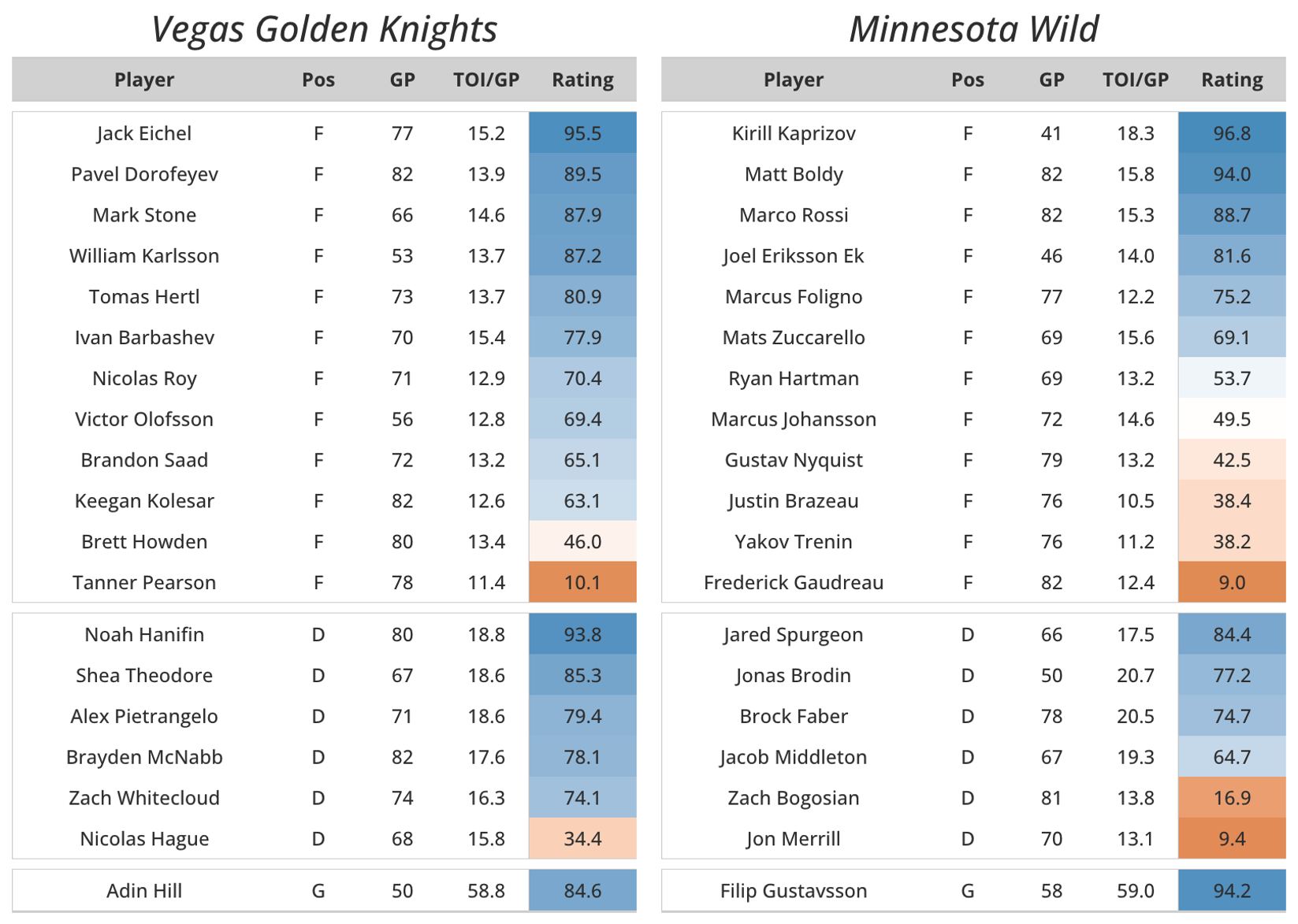
I hate the Golden Knights. I think this is the third year in a row that they’ve absolutely obliterated our preseason projections, and I’m starting to wonder if we should just ban them from the NHL because they are hurting my feelings, specifically. Now a few seasons removed from their Cup victory, Vegas is (sighing) still quite good. Like Los Angeles but way older, the Knights have assembled a very deep team with few weaknesses. They bring one of the best defensemen groups to the first round, back it up with a great goaltender in Adin Hill, and employ Mark Stone. I mean, why can’t our team projection models just like this team so I don’t have to dislike them? Of note, this particular Vegas team has relied on their ability to score goals with the extra man unlike any of their prior iterations: in ’24-25 they led all teams in RAPM GF/60. Interestingly, the Golden Knights finished 17th in all-situations shooting percentage, and their xG numbers seem to back up the +56 all-situations goal differential. With great seasons from several unexpected players (Pavel Dorofeyev, Tomas Hertl, Ivan Barbashev) and a few expected ones (Eichel, Stone), the Knights head into the first round with a Pacific Division crown and something to prove. I don’t know why they need to prove anything, but that’s probably what the TV broadcasts are going to say. The only hope we have is for America’s team, the Minnesota Wild, to smother them with their patented team defense which was absolutely on display when they let the ’24-25 San Jose sharks score 7 goals against them in game 79 when they hadn’t even clinched a playoff spot yet.
Ah yes, the first round. We meet again (this is me, talking as the Minnesota Wild). What a weird team. At the end of November, the Wild and Jets led the league in the standings, everyone in Minnesota thought this might finally be the team that would do the thing, and then 2025 happened. Minnesota had to, essentially, play full-time hockey until game 81 to grab the first wild card spot. Admittedly, a good portion of their struggles can be tied directly to long-term injuries to key players (Kaprizov and Eriksson-Ek specifically), but this team was never that good. The Wild finished ’24-25 with sub-50% totals in every even-strength shot metric on our site, and (along with Montreal) are the only playoff team heading into the first round with a negative all-situations goal differential. There are, however, a few reasons to be optimistic here. The Wild’s top forward line is legitimately among the best in the league when healthy, and our favorite player Marco Rossi and our should-win-the-Selke player Marcus Foligno make for great depth. Along with a solid top-4 covering several generations and some potential rookie-upset potential in newly recalled Zeev Buium’s expected debut in the playoffs, there are reasons to believe in this team. That said, if the Wild win this series it will be almost entirely because of Filip Gustavsson. Not that there aren’t holes in their opponent’s team, but come on, this is a Minnesota sports team in the playoffs after all. I’ll still be cheering for them, like always, and then ask “What else is on?” when they lose.
With that, let the games (that have already begun) begin.
— The Evolving Hockey Staff (Josh, Luke, and Shawn)
